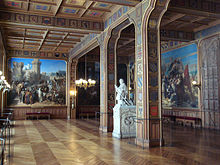Musée de l'Histoire de France (Versailles)
This article may rely excessively on sources too closely associated with the subject, potentially preventing the article from being verifiable and neutral. (April 2021) |
The Musée de l'Histoire de France (French pronunciation: [myze də listwaʁ də fʁɑ̃s] , useum of French History) is a museum that was created by King Louis Philippe I in the Palace of Versailles and opened in 1837. At the time, it represented an ambitious project of national reconciliation between the hitherto competing narratives of the French monarchy and the French Revolution, to which Louis-Philippe devoted significant personal attention. Whereas it gradually faded in importance as a museum in the later 19th century, its lavish historicist decoration remains a major exemplar of the art of France's July Monarchy.


History
editWhen Louis-Philippe became king in 1830 following the July Revolution, the Palace of Versailles had been mostly unoccupied for more than 40 years and had fallen into disrepair. Louis-Philippe, who had a personal interest in history, decided in 1833 to repurpose the massive building for a non-residential use.[1] His minister Marthe Camille Bachasson, Count of Montalivet was instrumental in the development of the museum project.
A number of new rooms and galleries were created by restructuring the palace's interior spaces and destroying a number of pre-existing apartments. The design was coordinated by architect Frédéric Nepveu, with assistance from Pierre Fontaine for the concept of zenithal lighting of the Galerie des Batailles.[2] The museum was inaugurated on 10 June 1837 with a lavish opening ceremony.[3] The museum displayed artefacts formerly in other national collections, especially portraits of past monarchs and other historically significant individuals, as well as works specifically commissioned for it.
Victor Hugo, who attended the inauguration, was appreciative of the project in his personal notes:[4]
What King Louis-Philippe has done in Versailles is good. By completing this work he has been a great king and an impartial philosopher, made a national monument from a monarchical one, put an immense idea in a gigantic edifice; installed the present in the past, 1789 face-to-face with 1688, the Emperor in the royal house, Napoleon in Louis XIV's home; in sum, bound that magnificent book known as French history into this magnificent binding known as Versailles.
— Victor Hugo, Feuilles paginées III[5]
Further work was carried out to expand the museum under the Second French Empire in the 1850s and 1860s[1] and in the early years of the Third Republic. In the late 19th century, however, Versailles curator Pierre de Nolhac put emphasis on the restoration of the pre-revolutionary state of the palace, and dismantled some of the museum's arrangements.[6]
The museum's rooms and collection are now managed by the Public Establishment of the Palace, Museum and National Estate of Versailles together with the rest of the palace and domains. Most of the corresponding galleries and exhibition spaces are not permanently open to the public.
Galleries and collections
editMost of the paintings are kept in the attics of the palace's North and South Wings.[1] These exhibition spaces are complemented by several prestige galleries:
- the monumental galerie des Batailles, occupying most of the South Wing's first floor on the garden (West) side, with 36 large-scale historical paintings and 82 busts of French military leaders who died in battle;
- the five salles des Croisades, opened in 1843 in the middle section of the North Wing's ground floor, celebrating the crusades as a specifically French endeavour (including Eugène Delacroix's Entry of the Crusaders in Constantinople, transferred to the Louvre in 1885 and replaced by a copy);
- the salle de 1792 connecting to the South Wing on the first floor, sole surviving one of several rooms dedicated to the French Revolution;[7]
- the Consulate and Empire Rooms on the South Wing's ground floor below the galerie des Batailles, on Napoleon and his military victories;[8]
- the salle de 1830 to the South of the galerie des Batailles, commemorating the July Revolution;
- the galleries of Africa, Crimea and Italy on the North Wing's first floor above the salles des Croisades, glorifying the French involvement under Louis-Philippe in the conquest of Algeria, the siege of Antwerp (1832) and the "Pastry War" with Mexico, as well as the later Second Empire's campaigns in the Crimean War and the Second Italian War of Independence;[9]
- the galeries de pierre, four long corridors (on the ground floor and first floor, in the palace's North and South wings) decorated with numerous sculptures of French historical figures.
With over 6,000 paintings and 3,000 sculptures, the museum's collections are the premier source of iconography on French history.[1]
See also
editNotes
edit- ^ a b c d "Les galeries historiques". Château de Versailles. 10 October 2016.
- ^ "Louis-Philippe et Versailles: Exposition du 6 octobre 2018 au 3 février 2019". Château de Versailles.
- ^ Marie-Douce Albert (31 December 2007). "Les travaux d'Hercule du château de Versailles". Le Figaro.
- ^ "Château de Versailles, sa construction et son histoire". Histoire pour tous. 6 May 2020.
- ^ French original text: Ce que le roi Louis-Philippe a fait à Versailles est bien. Avoir accompli cette oeuvre, c'est avoir été grand comme roi et impartial comme philosophe, c'est avoir fait un monument national d'un monument monarchique, c'est avoir mis une idée immense dans un immense édifice ; c'est avoir installé le présent dans le passé, 1789 vis-à-vis de 1688, l'empereur chez le roi, Napoléon chez Louis XIV ; en un mot, c'est avoir donné à ce livre magnifique qu'on appelle l'histoire de France cette magnifique reliure qu'on appelle Versailles.
- ^ Sabine Gignoux (25 October 2018). "Versailles réhabilite son musée Louis-Philippe". La Croix.
- ^ "The 1792 Room". Château de Versailles. 12 November 2018.
- ^ "The Empire Rooms". Château de Versailles. 12 November 2018.
- ^ "The Africa, Crimea and Italy Rooms". Château de Versailles. 12 November 2018.